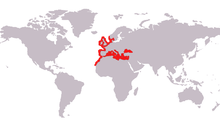
Brackish water, sometimes termed brack water, is water occurring in a natural environment that has more salinity than freshwater, but not as much as seawater. It may result from mixing seawater and fresh water together, as in estuaries, or it may occur in brackish fossil aquifers. The word comes from the Middle Dutch root brak. Certain human activities can produce brackish water, in particular civil engineering projects such as dikes and the flooding of coastal marshland to produce brackish water pools for freshwater prawn farming. Brackish water is also the primary waste product of the salinity gradient power process. Because brackish water is hostile to the growth of most terrestrial plant species, without appropriate management it is damaging to the environment.

Mariculture, sometimes called marine farming or marine aquaculture, is a specialized branch of aquaculture involving the cultivation of marine organisms for food and other animal products, in enclosed sections of the open ocean, fish farms built on littoral waters, or in artificial tanks, ponds or raceways which are filled with seawater. An example of the latter is the farming of marine fish, including finfish and shellfish like prawns, or oysters and seaweed in saltwater ponds. Non-food products produced by mariculture include: fish meal, nutrient agar, jewellery, and cosmetics.
Bass is a generic common name shared by many species of ray-finned fish from the large clade Percomorpha, mainly belonging to the orders Perciformes and Moroniformes, encompassing both freshwater and marine species. The word bass comes from Middle English bars, meaning "perch", despite that none of the commonly referred bass species belong to the perch family Percidae.
Sea bass is a common name for a variety of different species of marine fish. Many fish species of various families have been called sea bass.
A dace is a small fish that can be one of many different species. The unmodified name is usually a reference to the common dace. This, like most fish called "daces", belongs to the family Cyprinidae, mostly in subfamily Leuciscinae.

The Moronidae is a family of percomorph fishes, commonly called the temperate basses, in the order Moroniformes. These fishes are found in the freshwaters of North America and the coastal waters of the North Atlantic.

Demersal fish, also known as groundfish, live and feed on or near the bottom of seas or lakes. They occupy the sea floors and lake beds, which usually consist of mud, sand, gravel or rocks. In coastal waters, they are found on or near the continental shelf, and in deep waters, they are found on or near the continental slope or along the continental rise. They are not generally found in the deepest waters, such as abyssal depths or on the abyssal plain, but they can be found around seamounts and islands. The word demersal comes from the Latin demergere, which means to sink.

The flathead grey mullet is an important food fish species in the mullet family Mugilidae. It is found in coastal temperate, tropical and subtropical waters worldwide. Its length is typically 30 to 75 centimetres. It is known with numerous English names, including the flathead mullet, striped mullet, black mullet, bully mullet, common mullet, grey mullet, sea mullet and mullet, among others.

The Lessepsian migration is the migration of marine species along the Suez Canal, usually from the Red Sea to the Mediterranean Sea, and more rarely in the opposite direction. When the canal was completed in 1869, fish, crustaceans, mollusks, and other marine animals and plants were exposed to an artificial passage between the two naturally separate bodies of water, and cross-contamination was made possible between formerly isolated ecosystems. The phenomenon is still occurring today. It is named after Ferdinand de Lesseps, the French diplomat in charge of the canal's construction.

Argyrosomus regius, also known as the meagre, croaker, jewfish, shade-fish, sowa, kir, corvina, salmon-bass or stone bass, is a species of fish of the family Sciaenidae. This large fish has a pearly-silver to brownish coloration and a yellow-coloured mouth. It is native to the eastern Atlantic Ocean, as well as the Mediterranean and Black Seas.

As with other countries, the 200 nautical miles (370 km) exclusive economic zone (EEZ) off the coast of the United States gives its fishing industry special fishing rights. It covers 11.4 million square kilometres, which is the second largest zone in the world, exceeding the land area of the United States.
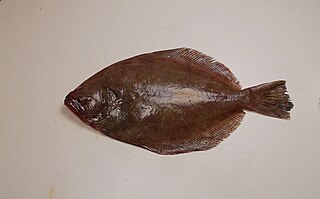
Paralichthys lethostigma, the southern flounder, is a species of large-tooth flounder native to the East Coast of the United States and the northern Gulf of Mexico. It is a popular sport fish and is the largest and most commercially valuable flounder in the western North Atlantic Ocean and Gulf of Mexico. It is a "left-eyed flounder", meaning the left side is pigmented and is the "up side".
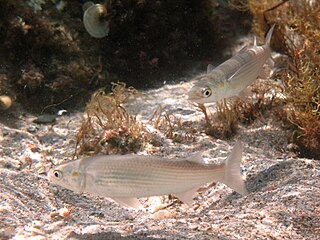
The golden grey mullet is a fish in the family Mugilidae.
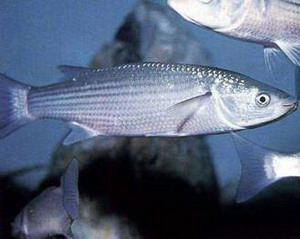
The thinlip mullet is a species of fish in the family Mugilidae. It is found in shallow European waters and is a migratory species.

Offshore aquaculture, also known as open water aquaculture or open ocean aquaculture, is an emerging approach to mariculture where fish farms are positioned in deeper and less sheltered waters some distance away from the coast, where the cultivated fish stocks are exposed to more naturalistic living conditions with stronger ocean currents and more diverse nutrient flow. Existing "offshore" developments fall mainly into the category of exposed areas rather than fully offshore. As maritime classification society DNV GL has stated, development and knowledge-building are needed in several fields for the available deeper water opportunities to be realized.

The spotted seabass is a species of ray-finned fish belonging to the family Moronidae, the temperate basses. This species is found in the marine and brackish waters of the coastal eastern Atlantic Ocean from the English Channel to the Canary Islands and Senegal, as well as through the Mediterranean Sea.

Dicentrarchus is a genus of ray-finned fishes belonging to the family Moronidae, the temperate basses. The two species in this genus are found in the eastern Atlantic Ocean and the Mediterranean Sea. The species in this genus are economically important food fishes.
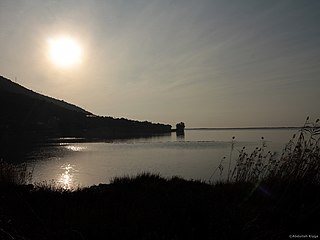
Beymelek Lagoon is a lagoon on the Mediterranean coast, which is used as a fishery, in Antalya Province, southwestern Turkey. It is named after the village of Beymelek, which is located to the west of the water body. The lagoon is situated in the Demre ilçe (district) of Antalya Province at coordinates 36°16′N30°03′E.

Ceratothoa oestroides is a crustacean isopod, obligate ectoparasite of marine fish that dwells in the buccal cavity. It is the causative agent of various pathologies including tissue damage at the parasitisation site (tongue), growth defects, decrease in mean host weight and size and increases mortalities in farmed and wild fish populations. It has been recorded in six different fish families: Sparidae, Carangidae, Clupeidae, Maenidae, Scorpenidae, and Mugilidae.

A third of fishing in Turkey is commercial fishing from wild fisheries but most is aquaculture. In 2018, the seafood sector provided employment to 52,937 people and produced 0.6 million tons of fish. According to the OECD, this produced a value of USD 1,481 million.

